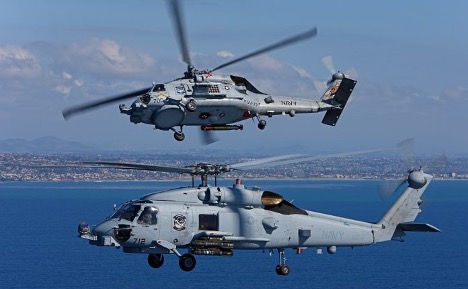Indian Navy to Acquire Seahawk Helicopters
In an article published by our partner India Strategic it was noted that:
India and the United States have finally signed the deal for 24 Sikorsky MH 60 R helicopters fir the Indian Navy.
The deal was signed Feb 25 under a G-to-G (Government to Government) arrangement, covered by the US FMS (Foreign Military Sales) Programme.
The conclusion of the deal, negotiated for years initially by Sikorsky, and then by Lockheed Martin which acquired this company, was finally pushed into the G-to-G process by the Indian Ministry of Defence.
Lockheed Martin will include the specifications given by the Indian Navy, and the costs and after sales support as negotiated now will be guaranteed by the US Government.
This article was published by India Strategic on February 25, 2020.
A Business Today article published on February 24, 2020 added further details.
Indian Navy is to soon have MH-60 multi-role Romeo Sikorskyhelicopters, which will give a boost to its in expanding its role in the Indian Ocean Region (IOR)….. The government-to-government deal, which was cleared on February 19, involves acquisition of 24 MH-60R 24 MH-60R Seahawk maritime helicopters from the US-based Lockheed Martin group…..
Key features of MH-60 Sikorsky Romeo multi-role helicopter
- The MH-60 is designed to hunt down submarines and will add to the strategic depth and combat capability of the Indian Navy.
- The fleet will boost the Indian Navy’s anti-surface and anti-submarine warfare operations. It is capable of conducting highly efficient reconnaissance missions.
- The MH 60 multi-role Romeo Sikorsky helicopters will replace ageing British-made Sea King helicopters. The first batch of formidable MH-60 Romeo helicopters is scheduled to be delivered by the US manufacturer in two years’ time.
- The multi-role helicopters will be deployed on warships and will be very effective in keeping the submarine threat posed by the extra-regional Navies, including China and Pakistan, in the Indian Ocean Region.
- The MH Romeo Seahawk helicopter is an advanced helicopter and a very potent Air ASW (AASW) platform.
- These helicopters will be used in Anti Submarine Warfare (ASW), Anti Surface warfare (ASuW), Command and Control, ESM roles besides Search and Rescue (SAR), Vertical Replenishment (VERTREP) roles, etc.
- The MH-60 helicopters, which are currently deployed with the US Navy, are considered as the most capable naval helicopter available today.
This acquisition is part of a general trend which Andrew McLaughlin of ADBR highlighted in an April 17, 2020 article.
Three recent major arms sales approvals by the US State Department for India have raised the possibility of that country being able to better integrate with the forces of other countries in the Indo-Pacific region.
Previously a large buyer of Soviet/Russian and French equipment, in recent years India has acquired Boeing C-17 and Lockheed Martin C-130J airlifters, the Boeing P-8I Poseidon maritime surveillance aircraft, and continues to examine the possibility of buying Boeing F/A-18E/F Super Hornets or Lockheed Martin F-16V/F-21s as it seeks to replace its large fleet of obsolete Soviet-era MiG-21s and MiG-23s.
In February the US Defense Security Cooperation Agency (DSCA) confirmed that the State Department had approved the foreign military sale (FMS) of an Integrated Air Defense Weapon System (IADWS) to India.
Based on the KONGSBERG/Raytheon NASAMS system similar to that being acquired by the Australian Army under LAND 19 Phase 7B, the approval includes the AN/MPQ-64Fl Sentinel radar system, AIM-120C-7/C-8 AMRAAM missiles, FIM-92L Stinger missiles, canister and vehicle-mounted launch systems, training systems, and various command and control elements.
Raytheon’s Sentinel radar is the same as that used by US and other countries’ NASAMS systems, whereas Australia will integrate advanced radars designed and manufactured locally by CEA Technologies.
Australia will use the same AMRAAM medium range missiles and is considering adding the longer-range AMRAAM-ER, but will also integrate the AIM-9X Block II missile instead of the shorter-range Stinger.
NASAMS is designed to be linked in with larger integrated air defence systems such as that planned for the ADF through Project AIR 6500. The adoption of NASAMS by India raises the possibility of closer defence ties through the conduct of joint air defence operations in major exercises such as Pitch Black, or in real-world operations.
More recently, DSCA advised in April that India had been approved to acquire the Boeing AGM-84L Harpoon anti-ship missile and the MK 54 light weight torpedo (LWT) for employment from its P-8Is.
Both weapons are also used by Australia and the US on their P-8A Poseidons, while South Korea and New Zealand are also expected to employ the same or similar weapons set on their P-8As when deliveries commence next year.

